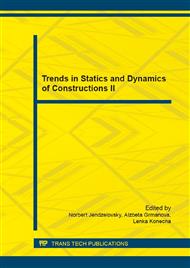p.131
p.135
p.140
p.146
p.152
p.157
p.163
p.167
p.175
Parameters of Acoustic Emission Signals Obtained During the Setting and Hardening of Concrete Mixtures with Different Water-Cement Ratio
Abstract:
Concrete hardening and setting processes are the most critical phases during construction work, influencing the properties of concrete structure. For this reason applying non-destructive testing in the early age of concrete lifetime can be useful. Acoustic emission method is a powerful tool for determination of lifetime concrete structures. Nevertheless, its application in civil engineering area is not easy because many building structures are inhomogeneous. This method can describe material changes during concrete lifetime. Acoustic Emission Method monitors concrete structure continuously. Changes in the whole concrete structure are recorded. The acoustic emission phenomenon is directly associated with nucleation of cracks in building materials, therefore the changes result from the volumetric expansion causing formation micro and macro cracking in structure, which we can recognize. Application of Acoustic Emission Method during concrete hardening and setting with different water-cement ratio will be the aim of this article and his influence on parameters of acoustic emission. A comprehension of microstructure-performance relationships is the key to true understanding of material behaviour.
Info:
Periodical:
Pages:
152-156
Citation:
Online since:
June 2016
Authors:
Price:
Сopyright:
© 2016 Trans Tech Publications Ltd. All Rights Reserved
Share:
Citation:


